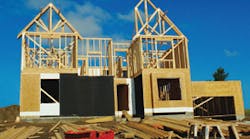The good times will continue to roll in the housing market, but they won't cruise along at quite the same pace as they did in 2005. That was the general consensus of economists at the National Association of Home Builders' (NAHB) 2005 Fall Construction Conference, held Oct. 19 in Washington, D.C.
David Seiders, NAHB's chief economist, is forecasting a decline in total housing starts from 2.032 million this year to 1.94 million in 2006 and 1.883 million in 2007. After that, he estimates that the annual production of new housing units (including manufactured homes) should settle around 2 million units for the 2008-2013 period.
NAHB projects single-family construction to decline from 1.683 million starts this year to 1.590 million in 2006 and to 1.533 million starts in 2007. Multi-family output, however, should remain close to the 349,000 level expected for this year through 2007.
Buoyed by low mortgage rates and red-hot customer demand, the housing market again confounded the experts in 2005, beating forecasters' estimates for the 10th straight year, according to Maury Harris, chief economist and managing director, USB Investment Banks, New York. But this remarkable run over the past decade has raised a few red flags at the Federal Reserve Bank and with other construction industry economists.
Fed Chairman Alan Greenspan has said speculation and “exotic financing options,” such as some of the new adjustable mortgages, are fueling a housing bubble that can't continue. Mark Zandi, chief economist, Economy.com, West Chester, Pa., has also voiced concerns about housing bubbles for several years. He agreed with Greenspan's comments that without the “exotic adjustable-rate financing” now available, many people could not afford homes in these markets.
This rapid growth has also pushed home prices to extreme levels. Zandi said all of California and Florida are now overvalued, and that much of the Northeast Corridor, including Washington, D.C, and Boston, will be at risk in the next three years if housing prices in those markets continue to rise. Bernard Markstein, NAHB's director of forecasting, said 50% of the nation's housing stock is overvalued this year, up from 33% in 2004.
Zandi also agreed with several other speakers that speculative buying is reaching alarming levels in some markets. David Bergson, vice president and chief economist of FanneMae, Washington, D.C., said investors own 25% of the homes in some metropolitan areas, and that these markets are most at risk if prices suddenly dropped because of adverse economic conditions.



